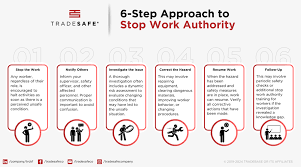How many points of contact should you maintain while climbing?
3 points of contact
Name the 3 components of a Personal Fall Arrest System (PFAS).
Anchor, body harness, or lanyard.
What is “Stop Work Authority”?
The right and responsibility to stop unsafe work
What is the purpose of a machine guard?
To protect from contact with moving parts
What’s the #1 cause of slip and trip injuries?
Poor housekeeping (clutter, spills, debris)
What’s the 4:1 rule for ladder setup? Extension ladder.
For every 4 feet in height, you move the ladder base one foot out.
How far must a worker stay away from an unprotected edge if no fall protection is in place?
At least 6 feet
Who has Stop Work Authority on the jobsite?
All employees: From entry-level workers to supervisors, every employee has the authority and responsibility to stop work.
Contractors: Contract workers also have the authority to stop work when they identify an unsafe condition.
Anyone at the site: In practice, anyone observing an unsafe situation is empowered to initiate a stop work command.
What must you do before removing or adjusting a guard?
Lockout/Tagout the equipment
Why is good lighting important in preventing slips and trips?
Poor lighting hides hazards like spills, cords, or uneven flooring
When setting up a ladder near a door, what must you do first?
Block, guard, or lock the door open so no one opens it into the ladder.
What should you do if your lanyard or harness has been involved in a fall arrest?
Remove it from service immediately — it cannot be reused until inspected or replaced
What should you do after stopping unsafe work?

What is “point of operation” in machine safety?
The area where work is performed on the material — such as cutting, shaping, drilling, or forming
What personal behavior most often leads to slip/trip incidents even in safe conditions?
Rushing, distractions (phones), or not watching where you walk
What should you do if a ladder label is missing or unreadable?
Tag it “Do Not Use” and remove it from service
What is the minimum strength required for an anchor point used in personal fall arrest?
5,000 pounds per worker attached (per OSHA 1926.502).
True or False: Using Stop Work could result in discipline.
False — it’s supported and encouraged
What is the key rule before reaching into or servicing any moving equipment?
Always perform Lockout/Tagout (LOTO) and verify zero energy
What type of flooring material helps reduce slip hazards in oily or wet areas?
Non-slip mats, grating, or textured surfaces designed for traction.
What should you do if you need to reach higher than your ladder allows?
Use the right ladder or equipment — never stack ladders or stand on objects for extra height.
What’s the purpose of a “swing fall” hazard check before tying off?
To ensure the anchor point is directly above you — minimizing side-swing impact if a fall occurs.
Give at least 3 examples of when to use Stop Work Authority.
Unsafe conditions:
Poor lighting or housekeeping
Unsecured work areas
Missing or improperly used personal protective equipment (PPE)
Changes in ground stability or site access
At-risk behaviors:
Working at heights without fall protection
Performing hot work near flammable materials Bypassing safety procedures like lockout/tagout Standing under a lifted load
Equipment issues:
Malfunctioning machinery
Improper use of equipment
Procedural and knowledge gaps:
Changes to the work plan without a new safety review
Lack of sufficient knowledge or training for a task
Witnessing someone not following the correct process
Emergencies:
Fire alarms or equipment failures
A near-miss incident that suggests underlying risks
Which of the following statements about machine guarding is true?
A. Interlocked guards can be bypassed if you have visual line-of-sight.
B. Self-adjusting guards are only for woodworking machinery.
C. Guards must prevent body parts from reaching the danger zone during operation.
D. Adjustable guards eliminate the need for Lockout/Tagout.
Answer: C. Guards are designed to prevent any body part from entering the danger zone — regardless of machine type.
Which factor contributes most to slip incidents according to the National Floor Safety Institute (NFSI)?
A. Footwear design
B. Floor surface material
C. Contaminants (like oil, water, or dust)
D. Lighting levels
Answer: C. Surface contaminants (oil, water, dust, etc.) cause the majority of slip incidents per NFSI research.